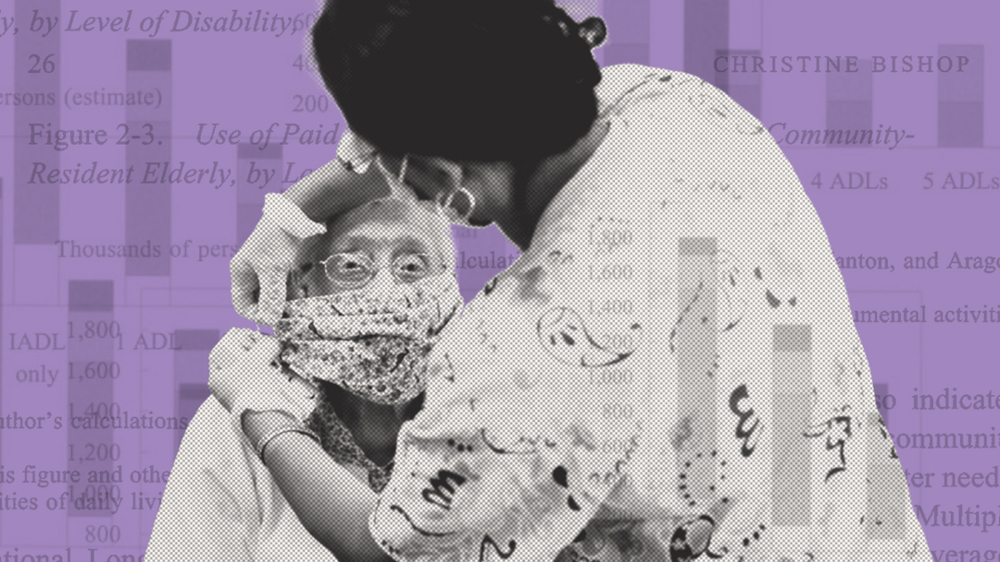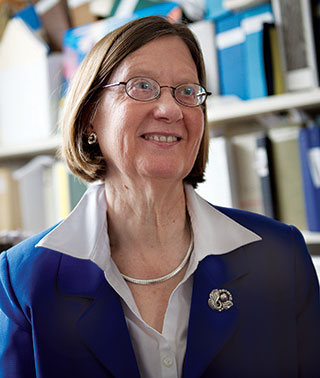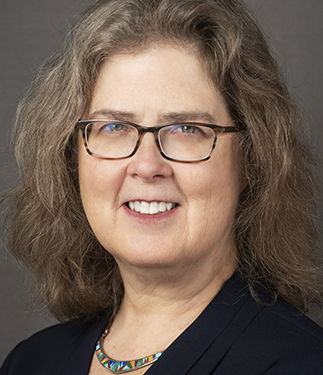
By Bethany Romano, MBA’17
The COVID-19 pandemic has devastated nursing homes. Of the over 10,000 Massachusetts residents to die from COVID-19 to date, 66% were living in long-term care facilities.
But it’s not just nursing home residents who face these risks: The pandemic laid bare the precarious position of the people who care for them. Their work is difficult and critical, yet poorly paid and under-appreciated. Nationally, 4.5 million people work as home health aides and personal care aides, 40-50% in the long-term care sector. People working in these roles are disproportionately Black, more than 40% are immigrants, and 84% are women.
Christine Bishop, the Heller School’s Atran Professor of Labor Economics, has studied nursing homes and other long-term services and supports for decades at the Institute on Healthcare Systems (IHS). Joining her this year is survey researcher Karen Donelan, the Stuart H. Altman Chair in U.S. Health Policy and an expert on health care workforce issues. Together, Donelan and Bishop provide a unique perspective on the unparalleled challenges facing nursing home staff during the pandemic, many of which have deep roots in labor policy, health care financing and long-term demographic trends.

Before the pandemic even began, both of you had done significant research on the difficulties that nursing home staff face. Could you describe some of these long-term issues?
Bishop: First, nursing home work is very difficult and physically taxing. It involves lifting and transferring residents, helping them with bathing and getting around, as well as dressing, eating, taking medications. The pandemic exposed what we haven’t been doing over many years, which is to ensure this workforce has adequate pay and benefits. Many of these workers—mainly women, often women of color and immigrants—are told that their underpaid job is “a calling,” but they can’t keep their family in groceries without taking a second job, and there are few opportunities for advancement.
These workers have high turnover, seldom have sick pay, and often live in households and communities that are quite dense. All of this contributes to the impact of COVID-19 in nursing homes, which exposed issues with staffing and brought it to a crisis point. One study conducted early in the pandemic used location data from cell phones to show that many nursing homes are connected by the workers who enter multiple nursing homes on a daily basis. Some likely unknowingly brought the virus with them.
In Massachusetts, by the third week in May, 350 of the state’s 388 nursing homes had at least one case.
Donelan: We know from studies conducted in Massachusetts before the pandemic that about one in five nursing home staff worked in more than one job. So people working in multiple nursing homes out of necessity, trying to feed their families, may have exacerbated the spread of the virus.
The long-term care sector relies heavily on an immigrant workforce to fill direct care needs. With this sector facing chronic labor shortages over the past two decades, new immigrants become a critical means to filling shortages. Many new immigrants face their own health and financial concerns, but also experience language and literacy barriers which may leave them even more vulnerable. In this pandemic we are all challenged to keep up with changing and complex information; assuring that workers understand the risks is essential.
During the first COVID-19 surge, there was a lot of attention to compromised workplace safety in terms of supplying nursing home staff with PPE [personal protective equipment]. Can you describe that?

Bishop: The Massachusetts Senior Care Association struggled to get PPE to their members; PPE was in very short supply for nursing homes. The lack of PPE made nursing home care work one of the most dangerous jobs in America.
Early data from the CDC from March through May estimates that about 25% of health worker deaths occurred among personal or home health aides. Nursing home deaths are 65% of the total COVID deaths in Massachusetts—but that’s referring to the residents. When we are able to look at COVID-19 impact by occupation, we’ll likely see some appalling numbers.
Donelan: So many things about this pandemic highlighted our inability to get supplies allocated in a fair way locally, regionally, nationally. We did not distribute testing, equipment, PPE or human resources adequately. There are reports that acute care hospitals were conserving PPE, preparing for their own surges, while nursing homes could not find any for their staff. Our early access to testing was so poor that it is hard to know how many people were impacted in the workforce.
In addition to the emotional stress and isolation experienced by residents and family members as family visitation was limited in nursing homes, there were also adverse impacts on staff. Suddenly, staff members had to “work short,” left without the help of family members and volunteers who visit regularly and help with everything from recreation to laundry, feeding and conversation.
Can you describe some of the short-term incentive measures that nursing homes enacted to compensate staff for working during the first COVID surge?

Donelan: This is already a dynamic workforce with a lot of turnover, and especially during early COVID-19 surges people were paying out all kinds of incentives to keep their staff on the job. Anecdotal reports of hazard pay, signing bonuses, housing support were all options.
Bishop: Some nursing homes asked staff to stop working at multiple locations. Some started paying hazard pay, and some increased all workers’ pay in the hope that workers would work all their hours at one nursing home rather than continuing to work a second job. Massachusetts offered a $1,000 bonus to attract new workers to fill vacant nursing home positions.
Were these short-term salary increases helpful?
Bishop: Actually, the bonuses and hazard pay might have made things worse. During the first surge, two different job banks were set up to recruit people off the street to fill nursing home jobs. At the same time, the criteria for working as a CNA [certified nursing assistant] were temporarily relaxed. How do you think that makes people feel, who have been doing this job for $12 an hour for so long?
At one point, clinical teams from the Massachusetts National Guard and from temporary staffing agencies were deployed to fill in at nursing home units—and received very high hourly pay. I can’t imagine how that worked for unit teams or for residents accustomed to care from their usual staff. I wouldn’t suggest those tactics be extended into the future.
Instead, nursing homes should increase and stabilize their existing workforce by offering higher pay and benefits to everyone doing this difficult job and guarantee full-time hours for workers who want to work full-time. Our research has also shown that respect from employers and from residents and their families, and good relationships with supervisors, are key elements supporting front-line worker engagement and retention.
It’s also important to remember that Medicaid pays for a very high proportion of long-stay nursing home residents. But the rates that Medicaid pays to nursing homes are notoriously low, much lower than what private-pay residents are charged. In Massachusetts, Medicaid temporarily increased the rates it paid to nursing homes, but a permanent increase in Medicaid payment would be necessary for nursing homes to permanently raise pay.
Donelan: You also need to consider the broader economic factors surrounding nursing homes. I study public perception about health care, and we know that for the last 30 years, despite the aging of our population, nursing home admissions have been declining. People with resources are doing everything they can to avoid nursing homes. In addition to that long-term trend, we also just lost a lot of residents who lived in these nursing homes to COVID-19. A lot of residents.
So now, the landscape is shifting. Who would not be afraid of being in a nursing home during a pandemic? We are studying how many residents moved back in with family during the pandemic, and how many passed away. We wonder how many nursing homes will close. Some of them will, certainly. The future of the nursing home industry and the population it serves is really complex and has huge implications for the workforce we need.
And I want to stress: Nursing homes are places that some people really need, especially people who don’t have family. As people live longer and longer, available caregivers within the family are fewer and farther between, so we need nursing homes or a much more robust system of community and home-based care. As with so many things, COVID put a spotlight on problems that we all knew were there, but that nobody was solving.
What do you envision as the path forward for nursing home workers?
Donelan: Several health workforce researchers nationally, including at the University of Washington, are thinking about the profound impact of the pandemic on hospitality and hotel workers, wondering if this is a workforce that might be retrained to work in long term care. We have to figure out how to make nursing home work safer and more fulfilling for workers and for residents.
Bishop: If nursing homes are to be welcoming and safe places to live for older adults who need them, we must recognize the cost of a stable, experienced workforce by authorizing Medicaid to pay nursing homes more. For decades nursing homes have complained about staff turnover and staff shortages. The answer, I think, is very simple: pay front-line workers more and make sure that they are respected for their knowledge, experience, and caring.
